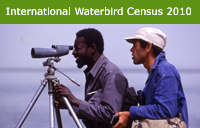International Waterbird Census taking place around the world this month

Bonn, 14 January 2010 - The 43rd International Waterbird
Census (IWC) - a monitoring initiative to count waterbirds
around the world is scheduled to take place in mid-January
2010, with the main recommended dates of the census set
for 16 and 17 January 2010.
The IWC scheme, which is coordinated by
Wetlands
International, is an annual census of waterbirds
in more than 100 countries and takes place in mid-January
each year. Close to 15,000 voluntary expert observers will
be counting between 30 and 40 million waterbirds using a
standardized method involving the collection, checking,
and importing of national and regional waterbird census
data. This makes it easy to compare the gained data of waterbirds
from Africa, Asia and Europe.
The IWC is a valuable source of information,
making it possible to monitor changes in waterbird numbers
and distribution, to improve knowledge of little-known waterbird
species and wetland sites, and to identify and monitor sites
that qualify as Wetlands of International Importance under
the Ramsar Convention on Wetlands. The census also provides
information on the conservation status of waterbird species
and helps to increase awareness of the importance of waterbirds
and their wetland habitats at local, national and international
level.
This year, special attention will be given
to the Slender-billed Curlew (Numenius tenuirostris),
a Critically Endangered wader and one of the most threatened
waterbird species of the 255 that are covered by AEWA. The
species was last definitely recorded in Hungary in 2001
and this year the Working Group under the Convention on
the Conservation of Migratory Species of Wild Animals (UNEP/CMS)
Memorandum of Understanding on the species, will organize
a number of targeted surveys to search for the Slender-billed
Curlew. The approach is to supplement the standard IWC counts
in January 2010 with specialized searches by separate teams.
If any birds are sighted, a satellite telemetry team will
travel to the site as quickly as possible and try to catch
and tag the bird. A special newsletter about the survey
was circulated by the Slender-billed Curlew Working Group
and can be found, together with search protocols and a host
of other material related to this work at: www.slenderbilledcurlew.net
The data collected through the IWC are
indispensable for Multilateral Environmental Agreements
such as the Ramsar Convention on Wetlands and AEWA; the
IWC data is also the basis for the AEWA Conservation Status
Report on Migratory Waterbirds (CSR). Unfortunately no sustainable
funding has been secured for this important work, which
depends on the 15,000 volunteers involved in collecting
the data in the coming days. These dedicated bird enthusiasts
play an extremely important role and their efforts are,
as always, highly appreciated.
For more information please visit:
-
"Wetlands International - International Waterbird Census
(IWC) - Slender-billed
Curlew Working Group Website: www.slenderbilledcurlew.net -
AEWA CSR4 - Report on the Conservation Status
of Migratory Waterbirds in the African-Eurasian Region
(PDF Document)
Dernière mise à jour le 16 Juin 2014


